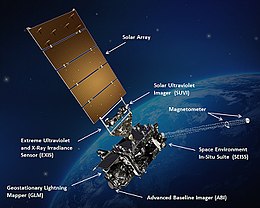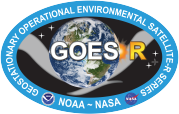GOES-16
 |
|
| Names | GOES-16 |
|---|---|
| Mission type | Earth weather forecasting, space weather |
| Operator | NOAA / NASA |
| COSPAR ID | 2016-071A |
| SATCAT no. | 41866 |
| Website | www |
| Mission duration | 15 years (planned) Elapsed: 6 months, 10 days |
| Spacecraft properties | |
| Spacecraft type | GOES-R series |
| Bus | A2100 |
| Manufacturer | Lockheed Martin |
| Launch mass | 5,192 kilograms (11,446 lb) |
| Dry mass | 2,857 kilograms (6,299 lb) |
| Dimensions | 6.1 x 5.6 x 3.9 m |
| Power | 4 kW |
| Start of mission | |
| Launch date | 23:42:00, November 19, 2016 |
| Rocket | Atlas V541 AV-069 |
| Launch site | Cape Canaveral SLC-41 |
| Contractor | United Launch Alliance |
| Orbital parameters | |
| Reference system | Geocentric |
| Regime | Geostationary |
| Longitude | 105° West |
| Semi-major axis | 42,164.0 kilometres (26,199.5 mi) |
| Eccentricity | 0.0001251 |
| Perigee | 35,788.1 kilometres (22,237.7 mi) |
| Apogee | 35,798.7 kilometres (22,244.3 mi) |
| Inclination | 0.01° |
| Period | 1,436.1 minutes |
| RAAN | 127.4027° |
| Argument of perigee | 240.1274° |
| Mean anomaly | 352.4533° |
| Mean motion | 1.00273071 |
| Epoch | 23 January 2017 |
|
|
|
GOES-16, previously known as GOES-R, is an American weather satellite, which, upon completion of testing, will form part of the Geostationary Operational Environmental Satellite (GOES) system operated by the U.S. National Oceanic and Atmospheric Administration. It is the first of the next generation of geosynchronous environmental satellite. It is expected to provide atmospheric and surface measurements of the Earth’s Western Hemisphere for weather forecasting, severe storm tracking, space weather monitoring and meteorological research. GOES-16 launched at approximately 23:42 UTC on November 19, 2016 from the Cape Canaveral Air Force Station, Florida, United States.
GOES-16 is a follow-on to the current GOES system that is used by NOAA's National Weather Service for weather monitoring and forecasting operations as well as by researchers for understanding interactions between land, ocean, atmosphere and climate. The GOES-R series program is a collaborative effort between NOAA and NASA to develop, deploy and operate the satellites. They are managed from Goddard Space Flight Center in Greenbelt, Maryland. The GOES-R series (GOES-R, S, T, & U) will extend the availability of the operational GOES satellite system through 2036. In November 2017, GOES-16 will be positioned as GOES-East at 75 degrees West longitude.
...
Wikipedia

